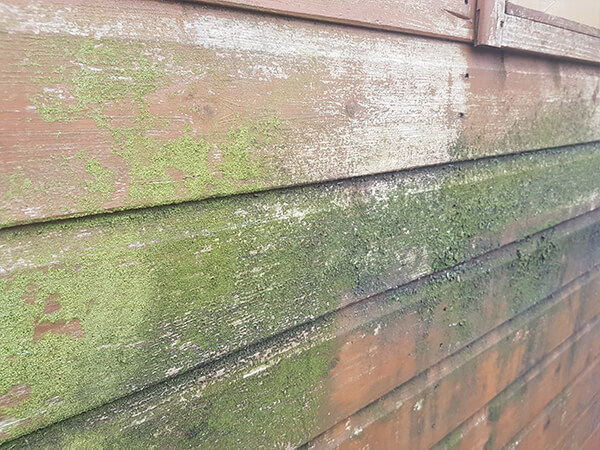Garden sheds take the brunt of all weathers from the heat of the summer sun, to the dark damp conditions of deep winter. Wind, rain and sun all contribute to the discolouration of shed timbers along with in-ground dirt and debris. The onset of mould, algae, mildew, and other biological growth on the wood can also look unsightly and accelerate wood rot and decay. It’s for this reason that a shed cleaner should be used from time to time or as part of your garden maintenance routine.

Why clean garden sheds?
Mould, algae, and other signs of biological growth are a good indication that shed timbers aren’t in the best condition, and if left untreated, sheds may not last as long as they may have otherwise. As long as wood rot hasn’t taken a hold, these condition can be reversed to restore sheds, summerhouses, and log cabins, preserving the wood and giving sheds a new lease of life for many more years.
What are wood cleaners?
Wood cleaners are formulated to not only clean the visible signs of dirt, mould, algae and fungi, they also kill off the spores in the wood grain from which they grow. This means that once the wood has been properly cleaned, and then treated with a wood or shed preservative, garden sheds and other wooden structures will be better protected against the re-growth of mould, algae, and other biological growth.
How to clean, preserve and protect garden sheds
restoring a garden shed to its former glory will likely take some effort but once done, it will look great and be ready to stand the test of time. To restore the appearance of the shed and give it the best possible protection, there are three main processes. These are…
- Cleaning
- Preserving
- Protecting
This process is based on bare wood garden sheds, or those that have been left untreated for a number of years and where the timber has perhaps turned grey or silver over time. If the shed has been previously painted or varnished and is showing signs of peeling, flaking or blistering, the old finish will need to be stripped back to bare wood before proceeding.
Cleaning wooden garden sheds
The amount of cleaning needed will depend on how heavily soiled the shed timbers are. For wood that is lightly stained with green or black patches, these can be treated with a mould and mildew cleaner. Once treated, allow the wood to dry and see if the stains have disappeared, if they remain, a second application may be required. For heavily contaminated sheds where there is a physical build up of mould or algae, the best approach is to remove as much of the surface contamination as possible with a paint scraper, stiff broom or brush. Treating the affected areas first with a mould and mildew cleaner and giving it an hour or two to soak in may make this process easier. When back to the bare wood, treat again and scrub the shed cleaner into the timber with a stiff brush then allow to dry. Repeat if necessary.
Top 4 Recommended wood cleaners suitable for garden sheds
- ULTIMA-PLUS XP MY1356 Wood Cleaner for Green Mould And Algae: An effective max-strength wood and stone cleaner that both wipes out green mould and algae. Forms a protective barrier that stops it from growing back, keeping your hard surfaces clean and protected for months after treatment
- Wet & Forget Mould, Lichen & Algae Remover: Highly effective cleaning and disinfecting concentrate. Works to remove mould, mildew, and algae.
Makes 30 Litres: Mix one part product to 5 parts waters to create the perfect ratio to remove mould from ANY outdoor surface including wooden sheds and fences - Roxil 100 Cleaner (1 x 5L & Sprayer): Roxil 100 5L with Pump Action Pressure Sprayer. Kills and removes green mould, algae, lichens and other biological growth. Versatile formulation usable on Patios, Decking, Driveways, Fences, Sheds and other hard surfaces.
- Pro-Kleen Spray and Walk Away Green Mould and Algae Killer: Pro-Kleen is a super powerful outdoor green mould and algae removing solution – the intense cleaning fluid revives patio, decking, fencing, outdoor furniture, and more and is safe for children and pets once dry!
Wood preservation
Once cleaned and allowed to dry, sheds should be treated with a shed preservative. Shed preservers will not eradicate mould or algae on their own but once the shed has been cleaned and treated with a mould and mildew cleaner, will help prevent future infestation. Shed and wood preservers are available in clear and coloured formulations so sheds can be left looking natural or stained to a different colour in a single process.
Shed Protection
Although shed preservatives protect against mould, algae and insect attack, they only offer limited protection against weathering and water ingress. To fully protect the recently cleaned and preserved shed, a top-coat of clear or coloured exterior wood oil, shed stain, shed paint or shed varnish should be applied. These will seal in the wood preservative to protect sheds from weathering and will complete the project.
Garden Shed FAQ’s
Can’t find the answer to your garden shed care or maintenance project above? See our frequently asked garden shed questions and answers page, where we try to answer some of the more commonly asked questions relating to garden shed care, maintenance, and shed treatments.
